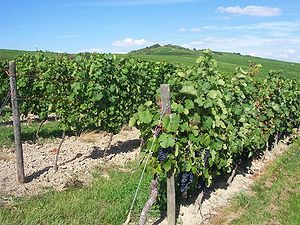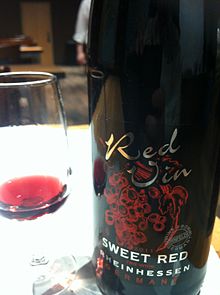Rheinhessen (wine region)

Rheinhessen(in English oftenRhine-HesseorRhenish Hesse) is the largest of 13German wine regions(Weinanbaugebiete) forquality wines (QbAandPrädikatswein)with 26,758 hectares (66,120 acres) under cultivation in 2018.[1][2][3]Named for the traditional region ofRhenish Hesse,it lies on theleft bank of the RhinebetweenWormsandBingenin the federal state ofRhineland-Palatinate.Despite its historic name it is currently no longer part of the federal-state ofHesse,this being the case since the end of World War II. There have been several unsuccessful attempts to legally reunite the former wine growing districts of Mainz on the Hessian side during the post-war area. Rheinhessen produces mostly white wine from a variety of grapes, particularly Riesling,Müller-ThurgauandSilvaner,and is best known as the home ofLiebfraumilch,although some previously underratedRieslingsare also made, increasingly in a powerful dry style.
The wine region is a member of the Great Wine Capitals Global Network.

Geography
[edit]The Rhine forms the eastern and northern boundary of the region, with the riverNaheto the west and theHaardt Mountainsto the south. ThePalatinate wine regionlies to the south, theRheingaulies across the Rhine to the north, and theNahe wine regionto the west. Known as the "land of the thousand hills", the terrain is undulating with vineyards mixed with orchards and other forms of farming. Its larger towns include:Mainz,Worms, Bingen,Alzey,Nieder-OlmandIngelheim.
In general the wines are best nearest the Rhine, where the soils impart more complex flavours. The best known area for white wines is the so-called Rhine Terrace (Rheinterasse;sometimes Rhine Front,Rheinfront) betweenOppenheimandNackenheim,which by itself is bigger than the whole of the Rheingau. A part of the Rhine Terrace, between Nackenheim andNiersteinis known as the Red Slope (Roter Hang) because of the presence of redslate.[4]The main red grape area is aroundIngelheim,in the north of the region opposite the Rheingau.
History
[edit]
Grapes have been grown in the region sinceRomantimes, andviticulturewas promoted byCharlemagne.The denominationGlöckis documented by a deed of donation from the year 742, it is the oldest appellation in Germany.
When the owners ofStadecken-Elsheimthe Counts ofKatzenelnbogenfirst cultivated Riesling in 1435 they called the wine from this part of their county theWine from the Gau.[5]At theCongress of Viennain 1814/15,Louis I, Grand Duke of Hesse,was awarded withRhenish Hesseas compensation for the loss of his Westphalian territories. As a result, he amended his title to "Grand Duke of Hesse and by Rhine" and the name of the region was created.
Liebfrauenmilch is named after theLiebfrauenkirche(Church of Our Lady) inWorms,which also was the name of a good and famous vineyard. Later, Liebfrauenmilch was used as a name for a semi-sweet wine style produced in several German regions, and became responsible for much of the erosion of the German wines' reputation on the export market. The most famous Liebfraumilch brand, until they changed their classification, wasBlue Nunwhich was created in 1921. Today, no quality-oriented top producer in Rheinhessen would dare to produce a Liebfrauenmilch for fear of losing their reputation.[citation needed]
Grape varieties
[edit]
On the 26,758 hectares of Rheinhessen's vineyards as of 2018, white grape varieties account for 71%.[1]After a period of increasing plantations of red grape varieties the balance between red and white varieties has been more stable in the last few years.Müller-Thurgau(usually labelled Rivaner when vinified dry), the prime ingredient in Liebfraumilch, is no longer the most grown with 15.6% of the area, has decreased significantly.Riesling,currently at 17.7%, has been increasing in the last few years. Among the red varieties,Dornfelderis the most planted at 12.6%, and it was Rheinhessen's second-most planted variety for a few years before being overtaken by Riesling in 2008.Silvanerat 8.1% is also widely planted, although it also has decreased significantly. Although in decline,Scheurebeat 2.8% has a special connection to the region sinceGeorg Scheubred it at the Alzey Research Institute in the region.
| Leading grape varieties in Rheinhessen (2022) | ||||
|---|---|---|---|---|
| Variety | colour | synonym | cultivated area (%) | cultivated area (ha) |
| 1.Riesling | white | Weißer Riesling | 19,4 | 5.304 |
| 2.Müller-Thurgau | white | Rivaner | 14,3 | 3.893 |
| 3.Dornfelder | red | 11,3 | 3.099 | |
| 4.Grauburgunder | white | Ruländer | 8,5 | 2.314 |
| 5.Silvaner | white | Grüner Silvaner | 7,1 | 1.932 |
| 6.Weißer Burgunder | white | Klevner, Pinot Blanc | 5,8 | 1.589 |
| 7.Spätburgunder | red | Pinot Noir | 5,5 | 1.490 |
| 8.Chardonnay | white | 3,7 | 1.019 | |
| 9.Blauer Portugieser | red | 3,4 | 926 | |
| 10.Scheurebe | white | Alzey S. 88, S 88, Sämling 88 | 2,7 | 733 |
Source: Statistisches Landesamt Rheinland-Pfalz[6][7]
Styles
[edit]Since more young winemakers received their oenological education at the renowned University of Applied Sciences inGeisenheimorWeincampus Neustadt,the quality increases year by year. Nearly all styles of wine may be found, old fashioned as well as new techniques.[8]Due to the competitive qualities at the yearlyVerband Deutscher Prädikatsweingüter(VDP) wine market held in Mainz, not all requests for the 2006 harvest could be granted.
Districts
[edit]
Rheinhessen is divided into the following three districts (Bereiche):
Bingen
[edit]In the northwest, towards the river Nahe; Scharlachberg is an important vineyard. In the town, one of the most renowned Liebfraumilch, Black Tower, is created by the Reh-Kendermann winery.
Nierstein
[edit]Source of most of the interesting wines of the region, and home to a third of the Riesling. TheRoter Hang(red slope) in the north of this area lies on a sandstone that is reputed to give the best wines, to the south the soils become deeper. [seeHipping]
Wonnegau
[edit]This district is situated aroundWorms.
See also
[edit]Notes and references
[edit]- ^abGerman Wine Institute, German Wine Statistics 2019–2020(PDF-file; 700 kB).
- ^Dieter Braatz, Ulrich Sautter, Ingo Swoboda, Jancis Robinson, Wine Atlas of Germany the best vineyards in Rheinhessen, University of California Press 2014; p. 117ff, retrieved on 27 October 2018.
- ^Wein.de (German Agricultural Society): Rhine-HesseArchived2007-10-30 at theWayback Machine,read on January 2, 2008.
- ^Wein-Plus Glossar: Rheinfront,read on January 24, 2013.
- ^Rheinhessen, The History of the County of Katzenelnbogen and the First Riesling of the World.
- ^Statistisches Landesamt Rheinland-Pfalz (2023),Bestockte Rebfläche der Keltertrauben 1999–2022 nach ausgewählten Rebsorten, Anbaugebieten und Bereichen(PDF),Mainz
{{citation}}:CS1 maint: location missing publisher (link) - ^Bestockte Rebfläche der Keltertrauben in Rheinhessen 1990–2022 nach Rebsorten
- ^Jason Wilson:How German Wine Found Its Sweet Spot,in:The Washington Postvom 5. September 2019.
Further reading
[edit]- Becht, Monika:Weinland Rheinhessen.(German) Frankfurt:Societäts-Verlag2005.ISBN3-7973-0936-8
- Mangold, Matthias F.:Rheinhessen im Glas.(German) Offenbach: Höma-Verlag 2006.ISBN3-937329-14-5.
- Priewe, Jens:WEIN DIE NEUE GROSSE SCHULE(German) Zabert Sandmann 1997ISBN3-932023-02-1
External links
[edit]- winedoctor.comGood overview of the region, concentrating on the Rhine Terrace.
- Rheinhessen:Rediscovered German Wine Country, Color Magazine, May 2011
- (en)German wines
- (de)Rheinhessen wines
- (de)Wineries, Companies and wine festivals in RheinhessenArchived2009-07-26 at theWayback Machine
- (en)list of Rheinhessen vineyards[permanent dead link]
